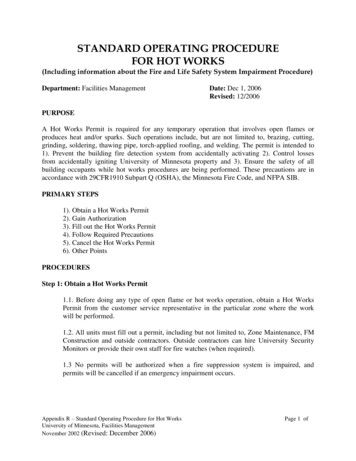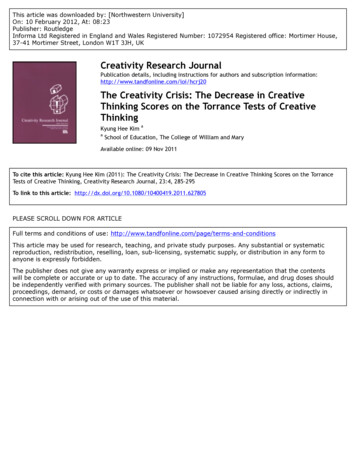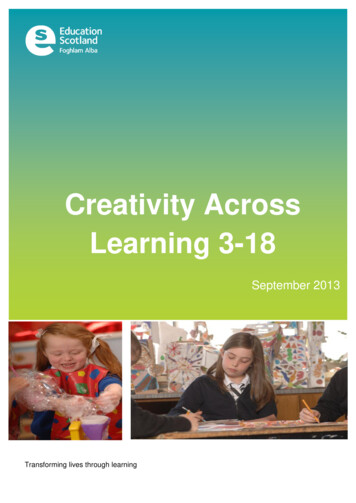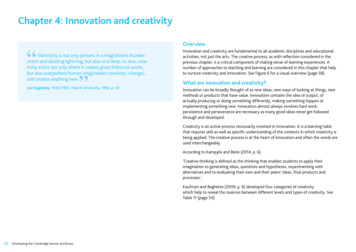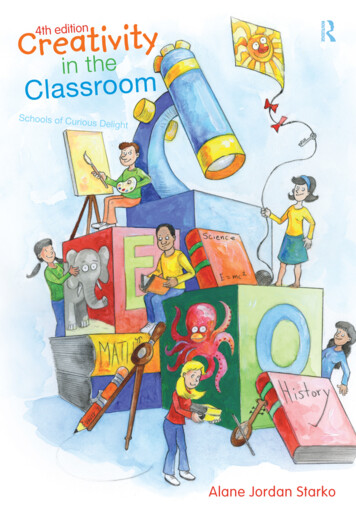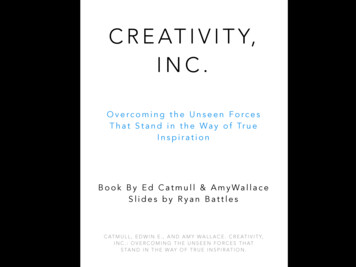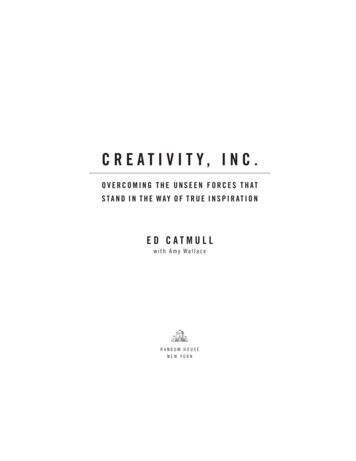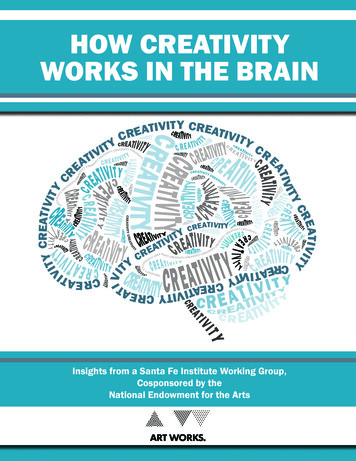
Transcription
HOW CREATIVITYWORKS IN THE BRAINcr r e a t i v i t yeativityivitc r y creattaeeativityivitr IVITYctiycRvCErt y ATIVITYc rIV e a t ieaiITYretivivcreativI it yittVITYcreativiteaTYtyATC RECytivitaecryREAe atTIVITYcREATIVIT Y CREATIVIcreativitHOWCREATIVITYcr eCVIWORKSINTHEBRAINAECRcreateativitritvitaet i i vi t yrCcreativ c r e at i v i t y V I TityTITICREATIVITREEAtivi ycreaCRR E A T IVITYTIVC REA T ItcCctivitycreativityCRativitycrevityREAtivityr e a ticTVIICTIREA EATIVcrTYtivityITYATIV REAivit y creatcreatATIVIreaCREit ytivityYREcreaIVITiviC REATVITYivit yEATIccreacreaticreC RREEAAT VIC R E AT ItivityyYYIT YVI TatCcreacreatCCvityrecreativC Rc Er e a t icTtyivYYTYATIVITYIVITYivityInsights from a Santa Fe Institute Working Group,Cosponsored by theNational Endowment for the ArtsYVITYityEATIVITCEATativityCRREATIyTYIVIEATcY CRCREATIVIT Y CREATIVITCRVIT YEATITtivityVITYcreatiTYCcreaY CREATICRcreTIVTIATIRE VIT YtivityA TIVITearcYTIVITEACRvityYcreaV I TYcreativityIVITYTIVItT ivitTYativrei v CR it yyC c r e a tivit R E A IcreativityatycreaEATtyyYCREATIVIvitycreatitivit yaerCy c REATIVITYCRTYvitytivityVITYVIeaVIATICREATIVIT Y CRECREATIATIvitytiCREcreatyIT Ya tiativrc eativat i v i ityrCREATIVIT Y yCREAcre ityTIVITctyreativityYcivicrTIVcreativity c rCREATIV vity TYI VITYCITATREVIATC REcreaae tiviTIR EAcCTYATCRETYYCIT YTIVEACR
How Creativity Works in the BrainInsights from a Santa Fe Institute Working Group,Cosponsored by the National Endowment for the ArtsJuly 2015
National Endowment for the Arts400 7th Street SWWashington DC 20506202-682-5400arts.govPrepared by Deanne and Gary Gute, Creative Life Research Center, University of Northern IowaProduced by the NEA Office of Research & AnalysisSunil Iyengar, DirectorEllen Grantham, Program AnalystMelissa Menzer, Program AnalystEditorial Assistance by Rebecca GrossDesigned by Kelli RogowskiThe NEA’s Office of Research & Analysis would like to thank the following individuals for valuable feedbackon the report: Eric Schulze, National Science Foundation; Bruce Carter, Florida International University; andRex Jung, University of New Mexico.Library of Congress Cataloging-in-Publication DataThe Nature of Creativity in the Brain (Meeting) (2014 : Santa Fe, N.M.)How creativity works in the brain : insights from a Santa Fe Institute working group / cosponsored by theNational Endowment for the Arts.pages cmIncludes bibliographical references.1. Creative ability--Congresses. 2. Creative ability--Physiological aspects--Congresses. I. Santa Fe Institute(Santa Fe, N.M.) sponsoring body. II. National Endowment for the Arts, sponsoring body. III. Title.BF408.T426 2014153.3’5--dc232015023504202-682-5496 Voice/TTY(a device for individuals who are deaf or hearing-impaired)Individuals who do not use conbentional print materials may contact the Arts Endowment’sAccessibility Office at 202-682-5532 to obtain this publication in an alternate format.This publication is available free of charge in print or PDF format at arts.gov, the website of the NationalEndowment for the Arts.
TABLE OF CONTENTSPreface . . . . . . . . . . . . . . . . . . . . . . . . . . . . . . . . . . . . . . . . . . . . . . . . . . . . . . . . . . . . . . . . . . . . . . . . . . . . . . . . . . . . . . . . . 7Executive Summary . . . . . . . . . . . . . . . . . . . . . . . . . . . . . . . . . . . . . . . . . . . . . . . . . . . . . . . . . . . . . . . . . . . . . . . . . . . . . 9Chapter One: Background and Rationale . . . . . . . . . . . . . . . . . . . . . . . . . . . . . . . . . . . . . . . . . . . . . . . . . . . . . . . . . 13What is Creativity? The Definition Challenge . . . . . . . . . . . . . . . . . . . . . . . . . . . . . . . . . . . . . . . . . . . . . . . . . . . . . 14Who Is “Creative?” . . . . . . . . . . . . . . . . . . . . . . . . . . . . . . . . . . . . . . . . . . . . . . . . . . . . . . . . . . . . . . . . . . . . . . . . . . . . 15Cognitive Components of Creativity . . . . . . . . . . . . . . . . . . . . . . . . . . . . . . . . . . . . . . . . . . . . . . . . . . . . . . . . . . . . . 16Working Memory . . . . . . . . . . . . . . . . . . . . . . . . . . . . . . . . . . . . . . . . . . . . . . . . . . . . . . . . . . . . . . . . . . . . . . . . . . . . . 17Divergent Thinking . . . . . . . . . . . . . . . . . . . . . . . . . . . . . . . . . . . . . . . . . . . . . . . . . . . . . . . . . . . . . . . . . . . . . . . . . . . 19Convergent Thinking . . . . . . . . . . . . . . . . . . . . . . . . . . . . . . . . . . . . . . . . . . . . . . . . . . . . . . . . . . . . . . . . . . . . . . . . . . 20The Brain’s “Magic Synthesis” . . . . . . . . . . . . . . . . . . . . . . . . . . . . . . . . . . . . . . . . . . . . . . . . . . . . . . . . . . . . . . . . 20Achieving Flow . . . . . . . . . . . . . . . . . . . . . . . . . . . . . . . . . . . . . . . . . . . . . . . . . . . . . . . . . . . . . . . . . . . . . . . . . . . . . . 21Chapter Two: Questions of Quantification . . . . . . . . . . . . . . . . . . . . . . . . . . . . . . . . . . . . . . . . . . . . . . . . . . . . . . . . 23How Is Creativity Measured? Current and Potential Approaches through Cognitive Psychologyand Neurobiology . . . . . . . . . . . . . . . . . . . . . . . . . . . . . . . . . . . . . . . . . . . . . . . . . . . . . . . . . . . . . . . . . . . . . . . . . . . . . 23Cognitive Assessments of Creativity in Individuals . . . . . . . . . . . . . . . . . . . . . . . . . . . . . . . . . . . . . . . . . . . . . . 23Neurobiological Evaluation and Intervention . . . . . . . . . . . . . . . . . . . . . . . . . . . . . . . . . . . . . . . . . . . . . . . . . . . 23Whose Creativity Merits Additional Research? . . . . . . . . . . . . . . . . . . . . . . . . . . . . . . . . . . . . . . . . . . . . . . . . . . . . 27Studying Creativity across Diverse Domains . . . . . . . . . . . . . . . . . . . . . . . . . . . . . . . . . . . . . . . . . . . . . . . . . . . . 29How Creativity Works in the Brain3
Chapter Three: New Pathways and Prospects . . . . . . . . . . . . . . . . . . . . . . . . . . . . . . . . . . . . . . . . . . . . . . . . . . . . . . 31Charting a Research Roadmap . . . . . . . . . . . . . . . . . . . . . . . . . . . . . . . . . . . . . . . . . . . . . . . . . . . . . . . . . . . . . . . . . . 31Mismatch between Interest and Support . . . . . . . . . . . . . . . . . . . . . . . . . . . . . . . . . . . . . . . . . . . . . . . . . . . . . . . 31Methodological Pitfalls . . . . . . . . . . . . . . . . . . . . . . . . . . . . . . . . . . . . . . . . . . . . . . . . . . . . . . . . . . . . . . . . . . . . . . 31Targeting Two Research Objectives . . . . . . . . . . . . . . . . . . . . . . . . . . . . . . . . . . . . . . . . . . . . . . . . . . . . . . . . . . . . . . 32Attendant Research Questions . . . . . . . . . . . . . . . . . . . . . . . . . . . . . . . . . . . . . . . . . . . . . . . . . . . . . . . . . . . . . . 32Limitations of Current Understanding . . . . . . . . . . . . . . . . . . . . . . . . . . . . . . . . . . . . . . . . . . . . . . . . . . . . . . . 32Proposed Approaches . . . . . . . . . . . . . . . . . . . . . . . . . . . . . . . . . . . . . . . . . . . . . . . . . . . . . . . . . . . . . . . . . . . . . 33Significance of Triangulating Phenomenological, Psychological, and Neuroscientific Approaches . . . 34Research Objective 2 . . . . . . . . . . . . . . . . . . . . . . . . . . . . . . . . . . . . . . . . . . . . . . . . . . . . . . . . . . . . . . . . . . . . . . . . . 34Attendant Research Questions . . . . . . . . . . . . . . . . . . . . . . . . . . . . . . . . . . . . . . . . . . . . . . . . . . . . . . . . . . . . . . 34Limitations of Current Understanding . . . . . . . . . . . . . . . . . . . . . . . . . . . . . . . . . . . . . . . . . . . . . . . . . . . . . . . 34Proposed Approaches . . . . . . . . . . . . . . . . . . . . . . . . . . . . . . . . . . . . . . . . . . . . . . . . . . . . . . . . . . . . . . . . . . . . . 35In Conclusion . . . . . . . . . . . . . . . . . . . . . . . . . . . . . . . . . . . . . . . . . . . . . . . . . . . . . . . . . . . . . . . . . . . . . . . . . . . . . . . . . 35References . . . . . . . . . . . . . . . . . . . . . . . . . . . . . . . . . . . . . . . . . . . . . . . . . . . . . . . . . . . . . . . . . . . . . . . . . . . . . . . . . . . . . 37Appendix: Participant Biographies . . . . . . . . . . . . . . . . . . . . . . . . . . . . . . . . . . . . . . . . . . . . . . . . . . . . . . . . . . . . . . . . 394National Endowment for the Arts
“Creativity is essential for the arts, for innovation, and forhuman flourishing. How Creativity Works in the Brain makes acompelling case for investing in the interdisciplinary researchneeded to understand, measure and foster creativity.”—Thomas Kalil, Deputy Director, White House Office of Science andTechnology Policy“As far as I know, How Creativity Works in the Brain is the bestcollection of perspectives about how the brain producesideas ‘out of the box,’ one of the principal ingredients ofcreativity.”—Mihaly Csikszentmihalyi, author of Creativity: Flow and the Psychology ofDiscovery and InventionHow Creativity Works in the Brain5
This Page wasintentionallyleft blank.6National Endowment for the Arts
PREFACEThe Nature of Creativity in the BrainWhat is the anatomy of an “aha” moment? Howand why did we evolve to have such experiences?Can we prime ourselves to have them moreoften? Why should we care? These and similarquestions were the recent focus of a cross-cuttinginvestigation by the National Endowment forthe Arts (NEA) in partnership with the Santa FeInstitute (SFI).It’s conceivable that soon we’ll be able to see whatan “aha” looks like in real time. Or to peer into theswarm of neural activity that occurs just beforethe lightbulb flashes on. Ultimately we might beable even to understand the physical attributes ofmemory and watch it construct fresh associationswith other knowledge, ideas, or experiences whenthe next “Eureka!” hits.SFI routinely brings together experts from variousfields to tackle complex research questions withfar-reaching consequences for policy-makers andthe general public. Questions about “the natureof creativity in the brain” amply merit this type oftrans-disciplinary dialogue. The arts and sciences,technological progress, economic prosperity—nearly every significant advance achieved byentire societies—are driven by human creativity.Yet somehow our understanding of how creativityshould be defined, nurtured, and optimizedremains surprisingly elusive.Spanning disciplines as varied as cognitivepsychology, neurobiology, education, and the arts,the Santa Fe Institute working group exploredthese possibilities in a two-day meeting. Theartists at the table were uniquely situated todescribe how creativity looks and feels from theinside. Their insights neither contradicted norperfectly aligned with the views of other speakers,some of whom considered creativity in terms ofnovelty and a capacity for problem-solving. Forthe artists who participated, creativity representedthe struggle to communicate or to invent newlanguages to illuminate new meanings andcontexts; for these artists, creativity is fueled bya basic desire to better understand ourselves andour place in the world.This soon may change. A sense of urgency isbuilding around the need to harness and spurcreativity to answer a broad range of societalconcerns. Creativity and innovation, alongwith critical thinking, problem-solving, andcollaboration, are viewed increasingly as essentialfor enabling our workforce to better compete inknowledge-based economies. At the same time,hundreds of millions of dollars and more than abillion Euros are pouring into large-scale effortsin the U.S. and in Europe to support medicalresearch and technologies that can improve ourunderstanding and manipulation of the humanbrain. The time is ripe for creativity research toassist in and benefit from those larger efforts.Why do humans feel compelled to pursue artisticendeavors? It depends on whom you ask. Anevolutionary biologist might explain that lioncubs find it fun to “play fight” on the savannah,but that this impulse is actually nature’s way ofhelping to foster important skills they’ll needin order to thrive as adults. Perhaps somethingsimilar is going on with us when we feelcompelled to play piano or put on a play. Oneof the best drama critics of all time wrote thatcatharsis consists of the ability to bring intellectualclarity to emotional chaos. If Aristotle was correct,then could it be that our impulse to make andengage with art of all types is actually nature’sway of helping us to develop the ability torecognize a signal in all the noise—to find patternsin what previously were a series of random dots?How Creativity Works in the Brain7
Just imagine what we might accomplish if wereally began to understand how creativity worksin the brain. We might transform the way weinvest in education so as to instill improvedproblem-solving and critical thinking capacitiesacross all levels of society. We might revampArtificial Intelligence to confront and solve theworld’s most wicked problems many times fasterand more effectively than we ever could. Or wemight be able to explain that the little girl playingjazz licks on the piano is actually building thepattern-recognition and improvisational skillsshe’ll need one day to cure the common cold,build a better burrito, or write a song that willteach the world to sing.It’s true that the pace of these advances canbe unsettling. Not everyone wants science orart to solve the various riddles that until nowwe’ve been forced to attribute to the ghost in themachine. But as E. B. White once wrote to a manwho had lost faith in the human race, “Man’scuriosity, his relentlessness, his inventiveness,his ingenuity have led him into deep trouble. Wecan only hope these same traits will enable him toclaw his way out.”Perhaps the fastest and most effective way forus to claw our way out will be via an all-handson-deck approach that synthesizes and activatesinsights across art, science, and the humanities inefforts to solve these riddles. Scientific validationtakes time. Art tends to work much quicker andmore intuitively, but it lacks the repeatable,quantifiable validity of science. Shakespearedidn’t wait for quantitative proof to guide the aimof his verse. He grabbed pen, paper, and poeticlicense and took a stab at revealing universaltruths—then he refined his work until it soundedright. In so doing, he revealed insights into thehuman condition that continue to resonate to thisday, and which science still struggles to explain.Inside this report you’ll get a taste of what canhappen when artists and scientists work togetherto identify problems and solutions that canaccelerate our ability to understand complexissues like the nature of creativity in the brain.This, literally, is the stuff that dreams are made of.And until we figure it out, we’ll never be able totruly understand the relentlessly curious “piece ofwork” that is a (hu)man.8National Endowment for the ArtsAnd, as any artist, scientist, or trans-disciplinarianworth her salt can attest: we have to know.Bill O’BrienSenior Innovation Advisor to the ChairmanNational Endowment for the ArtsJuly 2015
EXECUTIVE SUMMARYOverviewOn July 9-10, 2014, the National Endowment forthe Arts (NEA) and the Santa Fe Institute (SFI)cosponsored a meeting titled “The Nature ofCreativity in the Brain.” Held at SFI in Santa Fe,New Mexico, the meeting engaged a 15-memberworking group to perform two tasks:a) evaluate the legacy of creativity research; and Artists are unambiguously creative intheir intentions and activities. They aretherefore ideal partners and participants instudies of creativity in the brain. There need to be more partnerships amongneurobiologists and psychologists, artistsand educators to identify the conditions,correlates, and causes of creativity. There needs to be neuroscientificvalidation of existing tools to assesscreativity in individuals. These tests, ifeffective, can be adopted more widely byour nation’s educators, employers, andother decision-makers. The time for these research investments isnow, when new models, techniques, andtechnologies for studying the brain are stillin development.b) explore new knowledge at the intersections ofcognitive psychology, neurobiology,learning, complex systems, and the arts.Collectively representing all these fields, workinggroup members met just as large public-privateinvestments were starting to converge on basicneuroscience research—notably through theWhite House’s Brain Research through AdvancingInnovative Neurotechnologies (BRAIN) Initiative.The timing of the Santa Fe inquiry thus gave it anational policy dimension. By understanding thecognitive components of creativity, where theyreside in human neurophysiology, and how theymight be fostered for all Americans, the publicwill be poised better to articulate and monitor theimportance of creativity research in relation tobroader neuroscientific investments.Below are specific ideas and themes that emergedfrom the two-day meeting. They are treated moreextensively in this executive summary and in themain report itself. The creative process, exemplified by ournation’s artists and embodied in the dailylives of people from diverse backgrounds,merits closer study. Research on how creativity works in thebrain has strong potential value for U.S.health and education, the workforce andthe economy.Defining and Studying CreativityInitially, the central challenge for working groupmembers was how to define creativity. The wordmeans different things depending on one’s field ofexpertise or theoretical lens. For example, artistsPolly Carl and Doug Aitken described (and haveevinced) creativity in their independent efforts tochallenge public expectations of novelty in artwork.Meanwhile, creativity researchers in cognitivepsychology and neuroscience offered empiricalperspectives on concepts such as “novelty”and “value” or “utility.” While recognizing itslimitations, working group members tentativelyagreed that a baseline definition of creativity shouldaccount for the “novelty/value” dichotomy. Creativeoutput, they suggested, reveals both novelty andvalue.How Creativity Works in the Brain9
At the start of the meeting, cognitive psychologistMark Runco of the University of Georgiasummarized 30-year trends in the field ofpsychology-based creativity research. It rapidlybecame clear to working group members that nosingle generalizable theory of creativity has yetemerged. For that matter, members questionedwhether a uniform theory is even possible—ordesirable. As Robert Bilder of UCLA’s TennenbaumFamily Center for the Biology of Creativity noted,however, neuroscientific and cognitive-psychologystudies in broad populations have managed toisolate some plausible components of creativity.They include memory, divergent thinking, convergentthinking, and flow. Further delineation of thesecomponents could help define a conceptual path forgreater investments in creativity research.than would non-arts experiential learning.The team’s hypothesis was supported infindings that arts-integrated approachesto science learning helped students atmore basic levels of reading and writingproficiency retain more information longterm than students who began with strongerreading and writing skills. In this vein, participants representing cognitivepsychology and neuroscience reported results frominnovative research projects that are enabling a morecomplete understanding of these four components.Following a review of this progress, participantsoffered ideas for how research on creativity in thebrain can be accelerated and applied most effectivelyin coming years.Perspectives from Cognitive Psychologyand EducationThe most dramatic expansion in creativityrelated cognitive science research has centeredon psychometric assessment. For example,assessment batteries can test for fluency, flexibility,originality, and elaboration. Working group membersacknowledged that, as children progress throughthe U.S. school system, they typically have fewerchances to ideate with fluency but many occasionsto take standardized tests, which often requireconvergent thinking. Two presentations exploredspecific cognitive components of creativity and, ina broader sense, proposed alternative techniquesfor measuring student engagement with learning,beyond test scores alone. 10Mariale Hardiman of Johns HopkinsUniversity described her memory-centeredstudy of arts-integrated instruction in aBaltimore inner-city school. Her team’sresearch design incorporated dancemovement and other techniques in coursessuch as ecology and astronomy to test thehypothesis that arts-integrated methodswould produce better retention of materialNational Endowment for the ArtsIvonne Chand O’Neal, then at the John F.Kennedy Center for the Performing Arts,described Kennedy Center-sponsoredstudies of creative arts and learning in 16arts-integrated and 16 matched-controlschools in the Washington, DC-area. Herresearch suggested positive impacts onmultiple cognitive components of creativity,in particular the ability to generate agreater number of original ideas, and theenjoyment dimension of flow (a conceptpioneered by positive psychologistMihaly Csikszentmihalyi). Studentsin the arts-integrated classrooms alsoreported improved self-confidence, classparticipation, and persistence in problemsolving, relative to the control group.Perspectives from Neurobiology andNeurotechnologyOther participants showcased results fromneuroscientific studies driven by brain-imagingtechnologies such as Magnetic Resonance Imaging(MRI) and functional MRI (fMRI). As noted byJohn Stern of UCLA’s Geffen School of Medicine,the identification of brain networks through theseinstruments has “changed our entire concept ofcerebral function over the past 10 years or so.” Suchtools demonstrate that it is virtually impossible forthe brain ever to be at rest. In this session, Robert Bilder describedthe evolution of the brain and of brainresearch. Referring in particular to thecognitive dimension of flow and its role increativity, Bilder said flow achieves “a clearbalance of [the human brain’s] stable andflexible regimes. Those states involve highgenerativity, productivity, flexible memorycombination, and the successful inhibitionof intrusive habits or fixed ways of thinking,and they enable us to connect more clearlyto drive action or perception.”
John Stern, drawing from his clinical andresearch practice, explored perception asthe root of the brain’s connectivity andcreativity components. Stern describedatypical phenomena such as synesthesiaand seizures to illustrate the brain’scapability to connect disparate materials.He also discussed competition betweentwo mechanisms of consciousness: theself-reflective function of the brain’s defaultmode network versus the focused networkscontrolling motor function, language,movement, and vision.Justin Sanchez of the U.S. Defense AdvancedResearch Projects Agency (DARPA)described the development of neuralprosthetics and direct interfaces for the brainto restore normal movement or memory, orto restore function after neuropsychiatricillness. Sanchez’ presentation providedvideo examples of mind-machine interfacesconferring greater independence onamputees and other disabled populations.He discussed the possibility of one dayusing such devices to enhance or extendcreativity in humans.Charles Limb of the University of CaliforniaSan Francisco (then of the Johns HopkinsUniversity School of Medicine) reviewed thestrengths and limitations of brain-imagingtechnology and how it might be improvedas a research tool. Limb showed video of hisbrain-imaging lab and highlights from thework he has conducted for the last 10 yearsin exploring creativity as registered by thebrain activity of music-makers. Limb hasfocused on expert improvisational jazz andrap musicians, among other populations, toilluminate their neurological processes.Working Group ConclusionsHaving heard from each other on disciplinary trendsin creativity research, working group membersdiscussed how future breakthroughs might beenabled. Bill O’Brien, the NEA’s Senior InnovationAdvisor to the Chairman, observed that the idea ofmeasuring and optimizing creativity resonates withmany different policy imperatives at the nationallevel, yet “it remains an overheated, under-resourcedtopic.” Tension persists in the form of differentdisciplinary theories and methods for describing andinvestigating creativity.Ultimately, members acknowledged the truth intheater director and editor Polly Carl’s description ofthe art of perspective: “To see yourself small on thestage of another story; to see the vast expanse of theworld that is not about you, and to see your powerto make your life, to make others, or to break them,to tell stories rather than to be pulled by them.”Oriented to this mutually respectful philosophy,participants offered two sequential research goalsthat should be planted at the intersection of the arts,learning, cognitive psychology, and neuroscience.Research Objective 1Discover and describe the neurobiological correlatesand conditions under which different kinds ofcreative experiences occur, using a carefullyorchestrated, mixed-methods study design. Such astudy could be trans-disciplinary in approach andwould consist of three phases: Extract phenomenological data from firstperson subjective narratives of diversepopulations engaged in creative activity,to generate categories and hypotheses forpsychological and neurobiological testing; Correlate the experiences of creative peopleand their processes with well-validatedpsychometric instruments; and Correlate aspects of the creativeexperience with brain activity by usingthe most promising technology forimaging brain states, e.g., fMRI andelectroencephalography (EEG).Attendant Research Questions Is the onset of “flow,” as a psychologicalstate associated with creativity, linked to ashut-down or relaxation in the pre-frontalcortex (suggesting a relaxation or shutdown of self-consciousness)? How do aesthetic processes during artscreation link to the pleasure centers of thedopamine-driven midbrain system?Research Objective 2Submit behavioral assessments of creativity toneurobiological testing to validate them further forthe purpose of encouraging their widespread use byeducators and employers.How Creativity Works in the Brain11
Attendant Research Questions What psychometric and neurologicaltests can be used with K-12 students todetermine which instructional systems limitthe development of specific creative brainfunctions, and which allow educators toenhance those functions? What existing psychometric instrumentslend themselves most easily to validationthrough neurobiological analysis?The long-term societal benefits of pursuing theseresearch objectives were elucidated by CharlesLimb, himself both an artist (a musician) and aneuroscience researcher. “If we have done a goodjob of understanding this,” he said, “we will knowthe functional neuroanatomy, the neurobiologyof creative behaviors that are linked directly toinnovation and problem-solving. We should alsobe able to manipulate those circuits, so we shouldbe able to come up with [interventions] that willmake those things better, behavior therapies [and]technologies that are directly linked to improvingthings we can’t affect right now.”12National Endowment for the Arts
CHAPTER ONE:Background and RationaleTo understand the human brain in all its complexityis a newly defined area of focus for federalinvestments in biomedical and behavioral research.In 2013, the President launched the BRAIN Initiative,a public-private research effort “to give scientists thetools they need to get a dynamic picture of how wethink, learn, and remember.”i In collaboration withprivate foundations, universities, and corporations,the initiative’s lead federal entities include theDefense Advanced Research Projects Agency(DARPA), the National Institutes of Health (NIH),and the National Science Foundation (NSF). NIHrecognizes the BRAIN Initiative as an unprecedentedopportunity to explore “exactly how the brainenables the human body to record, process, utilize,store, and retrieve vast quantities of information, allat the speed of thought.”iiHealth, technological, and economic issues ofnational significance are driving this researchtrend. On the technology side, researchers want toknow how the brain will adapt to such advancesas everyday improvements in computing speed, orthe ever-proliferating surplus of on-command andunsolicited data. Google’s Director of EngineeringRay Kurzweil (author of The Singularity is Near, 2005)has predicted that over the next several years, 1,000of computing power will purchase an intelligenceexceeding that of the human brain. Yet myriadhuman problems remain unsolved. The currentAdministration counts The BRAIN Initiative amongits “Grand Challenges” demanding innovations inscience and technology.iiiThe foremost aim of the BRAIN Initiative is to spurdiscovery and testing of new treatments and curesfor brain disorders such as Alzheimer’s disease,Parkinson’s disease, traumatic brain injury, posttraumatic stress, and autism. Recognizing that theseconditions take an enormous toll on human andeconomic well-being, the Obama Administrationannounced, in partnership with universities,corporations, and private foundations, over 300million in support of the BRAIN Initiative in fiscalyear 2015.ivBut the importance of the BRAIN Initiative is notlimited to medical treatment applications. For thatmatter, the Administration’s 21st-century GrandChallenges are part of a larger vision called Strategyfor American Innovation, which invites publicprivate sector collaborators to confront challengesranging from national security to job security.Public-private, interdisciplinary collaborations willprove essential to answer
How Creativity Works in the Brain makes a compelling case for investing in the interdisciplinary research needed to understand, measure and foster creativity.” —Thomas Kalil, Deputy Director, White House Office of Science and Technology Policy “As far as I know, How C

